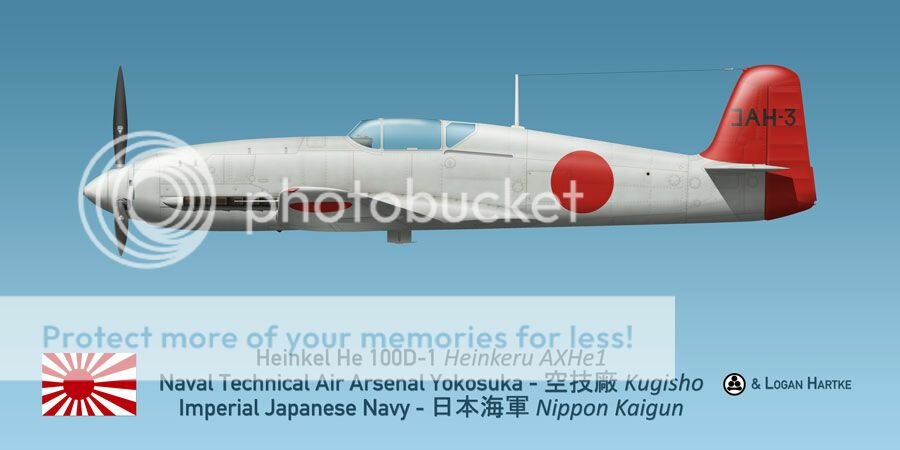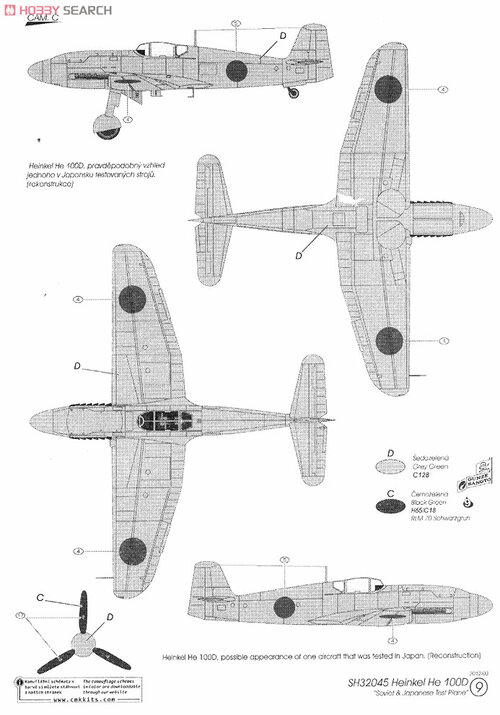blackkite
Don't laugh, don't cry, don't even curse, but.....
- Joined
- 31 May 2007
- Messages
- 8,819
- Reaction score
- 7,692
Hi! He100.
「Text from Erwin Hood's fantastic book "Heinkel He 100: Record Breaker".
It seems likely that the October 1939 Japanese delegation had been visiting Marienehe in preparation for the purchase of which had begun 11 months earlier. Three He 100 A-0s, presumably built as Section II airframes, were delivered to Japan in the summer of 1940, but there is evidence to indicate that drawings of an earlier version had been handed over to the December 1938 delegation. The does seem to have been an intention to produce a licence-built version of the He 100 in Japan for the Imperial Japanese Navy. The aircraft was given the official IJN designation of AXHe1 (Carrier-based fighter, Experimental, Heinkel, Type 1). A subsidiary of the Hitachi petrochemical concern, known as Hitachi Kokuki K K, was established in May 1939 expressly to produce not only a version of the He 100 but possibly also a licence-built version of the He 100. A factory was built in Chiba on the eastern side of Tokyo Bay. At least one of the He 100s was sent to the Naval Air Technical Centre in Yokosuka where, between 15 August and 10 September 1942, it was subjected to propeller vibration tests. Also noteworthy is the fact that it is described as a Heinkeru 100 Model Fighter, not as an AXHe1.
A note on the profile itself. This is a "what if" profile, but only in the sense that we don't know what the He 100s delivered to Japan really looked like once they arrived in Japan. To my knowledge, there are no known photographs of the aircraft of descriptions of their markings. Judging from the He 100s sold to the Soviet Union, I find it likely that they would have been painted in overall gray by Heinkel before delivery. We do have at least one photo of an He 112 that was purchased by the IJN, and the scheme I've put the He 100 in is based on that.
In mid-1940, Imperial Japanese Navy testing of the Heinkel He 100 (designated AXHe1 by the IJN) proved very successful and Hitachi was contracted to begin license production of the aircraft as soon as possible. A subsidiary of the Hitachi petrochemical concern, known as Hitachi Kokuki K K, was established in May 1939 expressly to produce the fighter at a new factory constructed in Chiba on the eastern side of Tokyo Bay. Intended for the land-based interceptor role, the 'A-' designation was carried over from the AXHe experimental He 100 purchased from Heinkel. Following on the designations for the A7He (Heinkel He 112) and A8V (Seversky 2PA-B3), the license manufactured He 100s were designated A9He. Unlike the US Navy, whose company designations reflected the manufacturer, in the Japanese Navy, the company designations reflected the designer, in this case Heinkel.
To power the new aircraft, Aichi license built the DB 601 as the Atsuta for the Navy, while Kawasaki built DB 601s for the Army as the Ha-40. In an effort to get more of the aircraft produced even sooner and as insurance against possible delays from the relatively inexperienced Hitachi, Nakajima was also contracted to begin production of the He 100 in late 1940. This led to the somewhat amusing scenario of Aichi producing Atsuta engines and delivering them to Nakajima to power A9He interceptors, while Nakajima was producing Sakae radial engines and delivering them to Mitsubishi to power the famous A6M "Zero" fighter, while Mitsubishi was producing Kinsei engines and delivering them to Aichi to power their D3A dive bombers!
The most major change to the He 100's design was the replacement of the troublesome retractable radiator with a fixed radiator aft of the wing and cockpit. This led to a reduction in top speed, but improved cooling drastically, something that would prove essential for use in the Pacific theater. In anticipation of the aircraft's service with the IJNAF, the Allies assigned the He 100 the nickname "Herman", reflecting its German heritage. The profile above depicts the prototype A9He1 produced by Hitachi. As the Aichi Atsuta engines were not yet ready, it was powered by a DB 601.」
Japanese Heinkel He 100s - The AXHe & Hitachi A9He "Herman"
Japanese Heinkel He 100s - The AXHe & Hitachi A9He "Herman"
www.whatifmodellers.com
「Text from Erwin Hood's fantastic book "Heinkel He 100: Record Breaker".
It seems likely that the October 1939 Japanese delegation had been visiting Marienehe in preparation for the purchase of which had begun 11 months earlier. Three He 100 A-0s, presumably built as Section II airframes, were delivered to Japan in the summer of 1940, but there is evidence to indicate that drawings of an earlier version had been handed over to the December 1938 delegation. The does seem to have been an intention to produce a licence-built version of the He 100 in Japan for the Imperial Japanese Navy. The aircraft was given the official IJN designation of AXHe1 (Carrier-based fighter, Experimental, Heinkel, Type 1). A subsidiary of the Hitachi petrochemical concern, known as Hitachi Kokuki K K, was established in May 1939 expressly to produce not only a version of the He 100 but possibly also a licence-built version of the He 100. A factory was built in Chiba on the eastern side of Tokyo Bay. At least one of the He 100s was sent to the Naval Air Technical Centre in Yokosuka where, between 15 August and 10 September 1942, it was subjected to propeller vibration tests. Also noteworthy is the fact that it is described as a Heinkeru 100 Model Fighter, not as an AXHe1.
A note on the profile itself. This is a "what if" profile, but only in the sense that we don't know what the He 100s delivered to Japan really looked like once they arrived in Japan. To my knowledge, there are no known photographs of the aircraft of descriptions of their markings. Judging from the He 100s sold to the Soviet Union, I find it likely that they would have been painted in overall gray by Heinkel before delivery. We do have at least one photo of an He 112 that was purchased by the IJN, and the scheme I've put the He 100 in is based on that.
In mid-1940, Imperial Japanese Navy testing of the Heinkel He 100 (designated AXHe1 by the IJN) proved very successful and Hitachi was contracted to begin license production of the aircraft as soon as possible. A subsidiary of the Hitachi petrochemical concern, known as Hitachi Kokuki K K, was established in May 1939 expressly to produce the fighter at a new factory constructed in Chiba on the eastern side of Tokyo Bay. Intended for the land-based interceptor role, the 'A-' designation was carried over from the AXHe experimental He 100 purchased from Heinkel. Following on the designations for the A7He (Heinkel He 112) and A8V (Seversky 2PA-B3), the license manufactured He 100s were designated A9He. Unlike the US Navy, whose company designations reflected the manufacturer, in the Japanese Navy, the company designations reflected the designer, in this case Heinkel.
To power the new aircraft, Aichi license built the DB 601 as the Atsuta for the Navy, while Kawasaki built DB 601s for the Army as the Ha-40. In an effort to get more of the aircraft produced even sooner and as insurance against possible delays from the relatively inexperienced Hitachi, Nakajima was also contracted to begin production of the He 100 in late 1940. This led to the somewhat amusing scenario of Aichi producing Atsuta engines and delivering them to Nakajima to power A9He interceptors, while Nakajima was producing Sakae radial engines and delivering them to Mitsubishi to power the famous A6M "Zero" fighter, while Mitsubishi was producing Kinsei engines and delivering them to Aichi to power their D3A dive bombers!
The most major change to the He 100's design was the replacement of the troublesome retractable radiator with a fixed radiator aft of the wing and cockpit. This led to a reduction in top speed, but improved cooling drastically, something that would prove essential for use in the Pacific theater. In anticipation of the aircraft's service with the IJNAF, the Allies assigned the He 100 the nickname "Herman", reflecting its German heritage. The profile above depicts the prototype A9He1 produced by Hitachi. As the Aichi Atsuta engines were not yet ready, it was powered by a DB 601.」
Attachments
Last edited:


